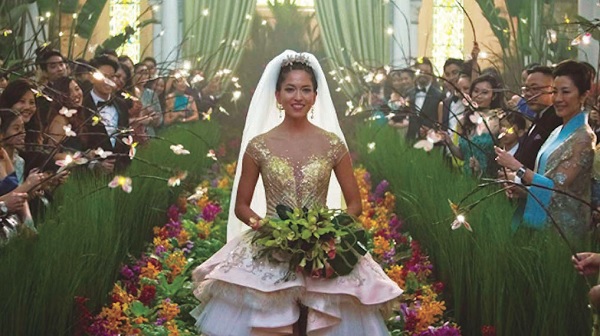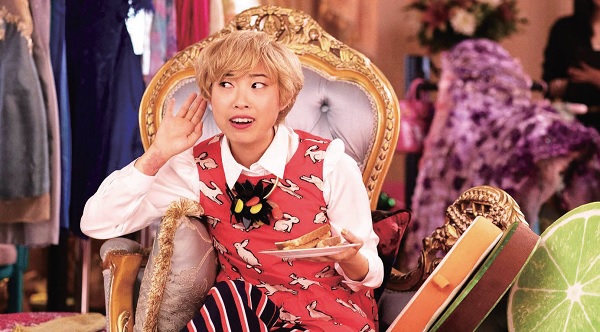The fun is yet to come!
"Crazy Rich Asians" Part 3
Translated by Lin Yu

not disappointed
At this moment, when I sit down to write my review of "Crazy Rich Asians", this movie that is being screened has just set a box office record for the most popular romantic comedy on the big screen in nine years, with a box office of more than 100 million US dollars in its first three weeks. , and also finalized the filming plan for the sequel.
Back when I saw the trailer for "Crazy Rich Asians" online a few months ago, I honestly didn't think it was that great. The trailer, which is just a few minutes long, has the rhythm and tone of a typical romantic comedy. Maybe I would have been excited to see it when I was 12 years old, but now I’m not willing to drag my adult self out to spend $18.

Then I accidentally clicked on some articles and social media posts and learned that this film is the first film produced by a major Hollywood studio in 25 years to feature all Asian actors. The man who created this film broke the long-standing ethnic barriers in the American film industry. This piqued my interest, and I wanted to support Asians in the media world, so on a weeknight, I sat with a few friends in a crowded, old theater in Union Square, New York.
Within minutes of the opening, I knew I wouldn’t be disappointed.
The film contains the formula of a romantic comedy, cheerful Chinese pop music from the 1950s and 1960s, handsome men and beautiful heroines, completely modern yet traditional Singapore scenes, and an extremely luxurious wedding, including Kina Grannis. Sing loudly to add to the fun.
The whole movie is full of laughter, and Goh Peik Lin, played by Awkwafina, is full of witty words and sarcasm is timely and on point. Michelle Yeoh plays the calm and powerful mother Elena, adding necessary drama and tension to the entire film. Constance Wu used the charm she exuded on the screen as Rachel Chu to prove to the audience and Hollywood that Asian-American heroines can really steal the show.

▲The whole movie is full of laughter. Goh Peik Lin, played by Awkwafina, is full of witty words and her sarcasm is timely and in place.
Weaving the embroidery of multiculturalism
The plot develops to the end, and we see Elena and Rachel facing each other on the mahjong table. This scene is beautifully arranged and atmospheric. Not only that, it also makes people feel warm. The audience cheered for Rachel, who had always been at a disadvantage, and she finally won the card game. Yes, if you don’t know Mahjong, you may not immediately understand its secrets. But that's the beauty of this movie—it doesn't shy away from mentioning things that only people of a certain ethnic group or nationality understand. Like when I heard a friend from Elena's Bible study class talk about Formosa Plastics, I couldn't help but chuckle.
This move is not about exclusion, but rather about inviting non-Asian audiences to understand our culture and accept that we are part of the cultural and ethnic tapestry of the United States of America. Hollywood has a long history of discrimination against all minorities, especially its depictions of yellowface, mocking accents, and stereotyping. It’s time for us to tell our stories.
Since the premiere of "Crazy Rich Asians," it has been reported that a number of films with more focus on Asian-American actors, stories, and culture are in the pipeline. "Searching" (also translated as "Human Flesh Search") starring John Cho is currently in theaters. Netflix has just released "To All the Boys I loved Before" (Chinese temporary translation), which is about a Korean-American high school girl who navigates her way through a relationship and discovers The secret love letter she wrote to her crush had actually been sent. There is also the Canadian comedy "Kim's Convenience" (Chinese translation), which has just been released to American audiences through Netflix. This revolution in the entertainment industry has just begun!
The country and the world are made up of people of different races, so it is important to tell stories that include and reflect various ethnic groups. We begin by taking the first step by acknowledging that cultural and ethnic diversity makes us better artists, storytellers, filmmakers, and ultimately, better people. I'm sure this will be the beginning of many more exciting, more tangled, more oriented stories to be presented to audiences.
By the way, I have lived in the United States for more than ten years, and I never thought that the language used at home would appear in a Hollywood film. But when Wu Peilin's mother Neena sputtered Hokkien, I thought my family had leapt onto the screen. This is the moment I feel most connected to in any American movie.
 Joan Kao is the art editor of the English version of this magazine and an interior designer. She currently works in Manhattan, New York. A self-confessed foodie and art enthusiast. Particularly interested in issues such as the intersection of art, popular culture, race and social justice.
Joan Kao is the art editor of the English version of this magazine and an interior designer. She currently works in Manhattan, New York. A self-confessed foodie and art enthusiast. Particularly interested in issues such as the intersection of art, popular culture, race and social justice.
